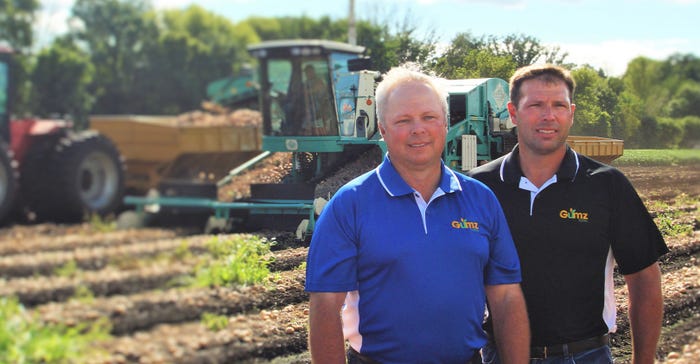October 11, 2019

Sniff the air in a few counties around the Endeavor, Wis., neighborhood from summer into fall and you get the strong but pleasant, nose-teasing aroma of mint — peppermint mostly, but spearmint, too.
Richard and Roderick Gumz grow hundreds of acres of mint. On 5,700 additional acres spread across four counties, they raise carrots, onions, red potatoes, corn and soybeans, almost exclusively on muck soils.
“That’s why we are spread out over as much area,” Richard says. “Ninety percent is muck soil. Red potatoes, onions and mint all grow better on muck soil.” Thus, the brothers operate farms in Columbia, Adams, Marquette and Sauk counties.
Gumz Muck Farms LLC uses tile, open ditches and drains “to keep water at bay and keep from flooding. It’s an ongoing process,” Richard says.
Sweet smell of success
The brothers strive for 70 to 75 pounds of peppermint oil per acre, which translates to 10 gallons from each acre. After steam distilling, the oil goes into 55-gallon drums and is sold for further refining, ultimately ending up in toothpaste or gum.
About 70% of the crop is sold to either Wrigley or Colgate, according to Richard. He and Roderick raised 800 acres of mint this year. They are equal partners and the fourth generation of their family to farm. Richard, who has been president of the Wisconsin Mint Board for 15 years, is in charge of land maintenance and the corn, soybean and mint crops. Roderick handles the carrots, onions and potatoes.
Other members of the family operate muck farms in Indiana, where the family started farming in 1892. They expanded into Wisconsin in the 1940s on land not exposed to verticillium wilt — “very damaging to mint,” Richard says. He joined the operation in 1987 after finishing college at Purdue University and marrying Linda, an agronomist who helps on the farm. Roderick came on in 1992, also after college and his marriage to Michelle, likewise a farm employee. She does the payroll for about 60 regular employees; that number reaches 100 at peak times.
Concentrating on cash crops, the brothers raise carrots for processing and onions and potatoes for the retail market with the Gumz label.
Mint harvest is from late July through August. Richard says the harvest is similar to alfalfa. Mint hay is windrowed, and after two to three days of drying time, a forage chopper blows the crop into steam wagons designed by the Gumz family.
“They’re all homebuilt,” Richard says, “connected to live steam through holes in pipes on the floor.” The resulting oil vapor is condensed to liquid and separated from the water for storage in barrels until it is marketed. The cooked hay is returned to the soil.
Richard points out that because of the nitrogen and other nutrients in muck soils, they can achieve 200-bushel corn crops. They also look for 22 to 24 tons of carrots per acre, 350 to 400 cwt of red potatoes and 900 to 1,000 50-pound bags of onions.
Wisconsin ranks fifth in the U.S. in mint production, with about 3,000 acres spread across a dozen farms. At 800 to 1,000 acres of mint, Gumz Muck Farms is one of the largest.
Gumz Muck Farms uses “a lot of cover and nurse crops for protection of the soil, for erosion and soil health,” Richard says. He acknowledges that muck soils “can be a challenge to tractors.” So, they use both flotation tires and tracks.
Weed control
Weed control is another major challenge, sometimes involving hand labor. “We have to avoid comingling [mint and weeds], or we get off-flavor,” Richard says. “Colgate wants consistency.”
He and Roderick belong to state and national organizations for all their crops. “There’s a lot of specialized equipment and a knowledge base we want to maintain for growers to keep a viable group of producers and markets,” he points out.
Oil prices, he says, are somewhat stable, but laments that demand is not increasing due to foreign competition and decreasing use around the world. “American oil is the premier product” on the world market, he says, “because of its distinctive flavor, but other countries don’t necessarily value that.” Thus, while prices may be stable, the downward pressure “hangs over our heads.”
Check out the slideshow to see photos of the operation.
Buchholz writes from Fond du Lac, Wis.
About the Author(s)
You May Also Like




